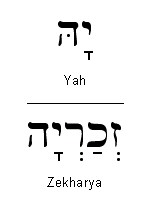
Mappiq
Encyclopedia
|-
| colspan="2" align="center" style="background:white;height:100px"|ּ
Romanization of Hebrew
Hebrew uses the Hebrew alphabet with optional vowel points. The romanization of Hebrew is the use of the Latin alphabet to transliterate Hebrew words....
|-
| colspan="2" align="center" style="background:white;height:50px"|גֹּבַהּ
|-
| colspan="2" style="width:250px;background:white" |
Hebrew language
Hebrew is a Semitic language of the Afroasiatic language family. Culturally, is it considered by Jews and other religious groups as the language of the Jewish people, though other Jewish languages had originated among diaspora Jews, and the Hebrew language is also used by non-Jewish groups, such...
, govah. The centre dot in the leftmost letter is a mappiq.
Diacritic
A diacritic is a glyph added to a letter, or basic glyph. The term derives from the Greek διακριτικός . Diacritic is both an adjective and a noun, whereas diacritical is only an adjective. Some diacritical marks, such as the acute and grave are often called accents...
used in the Hebrew alphabet
Hebrew alphabet
The Hebrew alphabet , known variously by scholars as the Jewish script, square script, block script, or more historically, the Assyrian script, is used in the writing of the Hebrew language, as well as other Jewish languages, most notably Yiddish, Ladino, and Judeo-Arabic. There have been two...
. It is part of the Masoretes
Masoretes
The Masoretes were groups of mostly Karaite scribes and scholars working between the 7th and 11th centuries, based primarily in present-day Israel in the cities of Tiberias and Jerusalem, as well as in Iraq...
' system of niqqud (vowel points), and was added to Hebrew
Hebrew language
Hebrew is a Semitic language of the Afroasiatic language family. Culturally, is it considered by Jews and other religious groups as the language of the Jewish people, though other Jewish languages had originated among diaspora Jews, and the Hebrew language is also used by non-Jewish groups, such...
orthography
Orthography
The orthography of a language specifies a standardized way of using a specific writing system to write the language. Where more than one writing system is used for a language, for example Kurdish, Uyghur, Serbian or Inuktitut, there can be more than one orthography...
at the same time. It takes the form of a dot in the middle of a letter (usually he
He (letter)
He is the fifth letter of many Semitic alphabets, including Phoenician , Aramaic, Hebrew , Syriac and Arabic . Its sound value is a voiceless glottal fricative ....
). An identical point with a different phonetic function (marking different consonants) is called a dagesh.

The mappiq is used to mark the letter he
He (letter)
He is the fifth letter of many Semitic alphabets, including Phoenician , Aramaic, Hebrew , Syriac and Arabic . Its sound value is a voiceless glottal fricative ....
(and rarely aleph
Aleph
* Aleph or Alef is the first letter of the Semitic abjads descended from Proto-Canaanite, Arabic alphabet, Phoenician alphabet, Hebrew alphabet, Syriac alphabet-People:*Aleph , an Italo disco artist and alias of Dave Rodgers...
), indicating that it is to be pronounced as a consonant, although in a position where the letter usually indicates a vowel.
Before the vowel points were invented, some consonants were used to indicate vowel sounds. These consonants are called matres lectionis. The letter he (transliterated H) at the end of a word (Hebrew is written from right to left) can indicate the vowel sound a or e. When it does, it is not acting as a consonant, and therefore in pure phonetic logic the Biblical name Zechariah (among others) should be spelled "Zekharya" without the final "h". However, silent final h being also a feature of English, it is usually retained in Hebrew transliterations to distinguish final he from final aleph.
The divine name Yah has a mappiq (a dot inside the last letter), so the last letter shall not be read as a vowel a, but as the consonant H - and therefore Yah (and not Ya).
The most common occurrence of mappiq is in the suffix "-ah", meaning "her".
A he with mappiq is meant to be pronounced as a full consonant "h", and in Mizrahi and Yemenite Hebrew it is pronounced more strongly than a normal he, sometimes with a slight following shwa
Schwa
In linguistics, specifically phonetics and phonology, schwa can mean the following:*An unstressed and toneless neutral vowel sound in some languages, often but not necessarily a mid-central vowel...
sound (this rule is also followed by Dutch Sephardim). In modern Hebrew, however, it is normally silent; although it is still pronounced in religious contexts by careful readers of the prayers and scriptures.
Rafe
In Masoretic manuscripts the opposite of a mappiq would be indicated by a rafe, a small line on top of the letter. This is no longer found in Hebrew, but may still sometimes be seen in Yiddish.See also
- Hebrew alphabetHebrew alphabetThe Hebrew alphabet , known variously by scholars as the Jewish script, square script, block script, or more historically, the Assyrian script, is used in the writing of the Hebrew language, as well as other Jewish languages, most notably Yiddish, Ladino, and Judeo-Arabic. There have been two...
- Hebrew phonologyHebrew phonologyThis article is about the phonology of the Hebrew language based on the Israeli dialect. It deals with current phonology and phonetics as well as with historical developments thereof, including geographical variants....
- Mater lectionisMater lectionisIn the spelling of Hebrew and some other Semitic languages, matres lectionis , refers to the use of certain consonants to indicate a vowel. The letters that do this in Hebrew are aleph, he, waw and yod...
- Rafe

